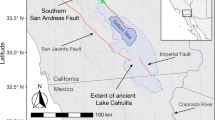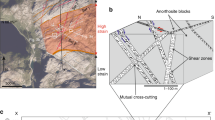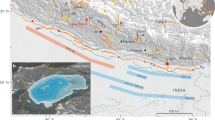Abstract
North Atlantic sediments dating from the last ice age contain layers of rock fragments from northeastern Canada (so-called Heinrich layers)1. Like modern iceberg-borne sediments from Greenland, these layers have been attributed to ice-rafting episodes1,2,3. Six Heinrich layers have been documented and correlated with climate changes4,5,6,7,8. The layers, which are several centimetres thick, contain negligible amounts of foraminifera (which accumulate at a few millimetres per century), implying that they were deposited over just a few years. These ice-rafting Heinrich events are separated by progressively shorter intervals from about 40 to 6 kyr (ref. 9), and it has been suggested10 that they are related to the Milankovitch cycles in the Earth's orbital parameters11. Alternatively, they may be generated by forcing mechanisms arising from the internal dynamics of the Laurentide ice sheet12. Here we suggest the possibility that the Heinrich events were precipitated by ice-load-induced earthquakes, analogous to those produced by reservoir water loads13. We suggest that near its edge, the Laurentide ice sheet sheared the Earth's crust, inducing repeated failure that released the ice rafts. This region (along Canada's northeastern seaboard) shows evidence of both current14,15 and past seismic activity owing to postglacial rebound. Our model accounts for the intervals between both the Heinrich events and the evidence of palaeoseismicity, and can be tested by studying local sedimentary relationships.
This is a preview of subscription content, access via your institution
Access options
Subscribe to this journal
Receive 51 print issues and online access
$199.00 per year
only $3.90 per issue
Buy this article
- Purchase on Springer Link
- Instant access to full article PDF
Prices may be subject to local taxes which are calculated during checkout



Similar content being viewed by others
References
Heinrich, H. Origin and consequences of cyclic ice rafting in the Northeast Atlantic Ocean during the past 130,000 years. Quat. Res. 29, 142–152 (1988).
Andrews, J. T. & Tedesco, K. Detrital carbonate-rich sediments, northwestern Labrador Sea; implications for ice-sheet dynamics and iceberg rafting (Heinrich) events in the North Atlantic, Geology 20, 1087–1090 (1994).
Bond, G.et al. Evidence for massive discharges of icebergs into the north Atlantic ocean during the last glacial period. Nature 360, 245–249 (1992).
Grimm, E. C., Jacobson, G. L. Jr., Watts, W. A., Hansen, B. C. S. & Maasch, K. A. A50,000 year record of climate oscillations from Florida and its temporal correlation with the Heinrich events. Science 261, 198–200 (1993).
Lowell, T. V.et al. Interhemispheric correlation of late Pleistocene glacial events. Science 269, 1541–1549 (1995).
Broecker, W. S. Massive iceberg discharges as triggers for global climate change. Nature 372, 431–424 (1994).
Bond, G.et al. Correlations between climate records from North Atlantic sediments and Greenland ice. Nature 365, 143–147 (1993).
Baltuck, M., Dickey, J., Dixon, T. & Harrison, C. G. A. New approaches raise questions about future sea level changes. Eos 77, 385–388 (1996).
Shackleton, N. J., Imbrie, J. & Hall, M. A. Oxygen and carbon isotope record of East Pacific Core V19–30; implications for the formation of deep water in the late Pleistocene North Atlantic. Earth Planet. Sci. Lett. 65, 233–244 (1983).
Bond, G. & Lotti, R. Climate forcing of millennial-scale ice rafting cycles in the North Atlantic. Eos 75, 332 (1994).
Hays, J. D., Imbrie, J. & Shackleton, N. J. Variations in the earth's orbit: pacemaker of the ice ages. Science 194, 11221–1132 (1976).
Alley, R. B. & MacAyeal, D. R. Ice-rafted debris associated with binge–purge oscillations of the Laurentide ice sheet. Paleoceanography 9, 503–511 (1994).
Gupta, H. K. & Chandha, R. K. (eds) Induced Seismicity (Pure Appl. Geophys. Vol. 145, 1995).
Hasegawa, H. S. & Basham, P. W. in Earthquakes at North-Atlantic Passive Margins: Neotectonics and Postglacial Rebound (ed. Gregersen, S. and Basham, P. W.) 483–500 (NATO Advanced Study Institutes Series C, Vol. 266,(1989).
Geological Survey Canada, http://www.seismo.nrcan.gc.ca/sheishaz4gen123.html
Arvidsson, R. Fennoscandian earthquakes: whole crustal rupturing related to postglacial rebound. Science 274, 744–745 (1996).
Johnston, A. C. Awave in the earth. Science 274, 735 (1996).
Andrews, J. T. A Geomorphological Study of Post-Glacial Uplift with Particular Reference to Arctic Canada (London Institute of British Geographers, London, 1970).
Tucker, C. M., Leckie, D. A. & McCann, S. B. Raised shoreline phenomena and postglacial emergence in south-central Newfoundland. Geomorph. Phys. Quat. 36, 165–174 (1982).
Lay, T. & Wallace, T. C. Modern Global Seismology (Academic, New York, 1995).
Broecker, W. The Glacial World According to Wally (Lamont-Doherty Earth Observatory, Palisades, 1995).
Cathles, L. M. II The Viscosity of the Earth's Mantle (Princeton Univ. Press, 1975).
Sieh, K. E. in Earthquake Prediction (ed. Simpson, D. W. and Richards, P. G.) 181–207 (American Geophysical Union, Washington, 1981).
Bird, J. B. The Physiography of Arctic Canada (Johns Hopkins Univ. Press, 1967).
Acknowledgements
We thank G. Bond and J. Park for insightful and considered reviews, and our colleagues for their patient help in understanding Heinrich events.
Author information
Authors and Affiliations
Corresponding author
Rights and permissions
About this article
Cite this article
Hunt, A., Malin, P. Possible triggering of Heinrich events by ice-load-induced earthquakes. Nature 393, 155–158 (1998). https://doi.org/10.1038/30218
Received:
Accepted:
Issue Date:
DOI: https://doi.org/10.1038/30218
This article is cited by
-
Dyke to sill deflection in the shallow heterogeneous crust during glacier retreat: part I
Bulletin of Volcanology (2023)
Comments
By submitting a comment you agree to abide by our Terms and Community Guidelines. If you find something abusive or that does not comply with our terms or guidelines please flag it as inappropriate.



